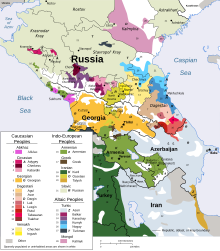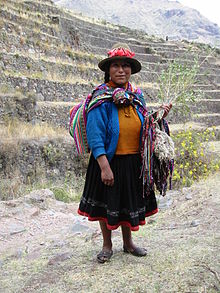Hill people
In parts of the developing world the mountain communities depend on remittances from young men who have gone to work in the lowlands or overseas.[1] 22% of the world's land, or 29,000,000 square kilometres (11,000,000 sq mi) is classified as a mountain region, of which about half is below 1,000 metres (3,300 ft).[1] Mountain regions in a 2003 study by the Food and Agriculture Organization (FAO) of the United Nations follow the WCMC classification.[2] The mountain environment can be harsh, particularly in the alpine regions above the tree line at higher elevations and in the drier climates outside the tropics.[4] Usually there are strong winds, frequent freezing and thawing at the higher levels, snow, sleet and heavy rainfall in some areas, causing steady erosion.[11] Threats include environmental stress during adaptation to higher mean annual temperatures, changes to precipitation patterns and more frequent extreme weather events.[12] It is difficult to predict how well the mountain populations will adapt to changes in the resources on which they rely for subsistence, although it seems clear that there will be increased competition for use of the land for different purposes.[6] Streams, rivers and lakes that provide water for agriculture and domestic use are often found in valleys with flat ground suitable for cultivation of crops.[7] The rugged mountains of the island of Papua New Guinea contain fertile valleys with temperate climates that are densely farmed using traditional techniques.This is true of the Tibetans, Naxi, Miao, Yi and Uyghurs in China, the Kurds in the north of Iraq and the east of Turkey, the Amhars in Ethiopia and the Quechua and Aymara in the Andes.[7] While mountain areas are more isolated than lower or flatter lands, when measured by the percentage of the population that lives more than 5 kilometres (3.1 mi) from a road the difference is not great as might be expected.[16] The countries with the highest percentages of mountain people are Bhutan (89%), Rwanda (75%), Lesotho (73%), Armenia (70%), Guatemala (64%), Costa Rica (63%) and Yemen (61%).[23] Forestry and traditional agriculture is declining in the mountain areas of Japan, Europe and the eastern United States as government subsidies are withdrawn.[24] Outside Europe and Japan the human population in mountains is rising as they are used as refuges, sources of minerals, for tourism, and for commercial forestry, farming and animal husbandry.[25] Long term high-elevation residents have expanded lungs and hearts, higher levels of hemoglobin in their blood and shorter limbs.[28] The people of the tropical high mountains experience more exposure to solar irradiance than lowlanders, and must adapt to wider temperature extremes between day and night.[33] Later human settlers in the mountains practiced a combination of hunting and gathering, raising crops and tending livestock, with most families involved in all these activities.This trend has accelerated in the last 400 years, driven by the industrial revolution and colonialism, the transition to commercial produce such as furs and minerals, and the recent growth of tourism.[36] A comparison of crops grown in southern Switzerland, the Peruvian Andes and the Central Nepal Himalaya shows strong similarities.[28] Higher up the production gives way to tubers such as potatoes, then to forest, and then at high elevations to pasture for sheep, cattle, goats, and in Peru for camelids.[37] The volcanic mountain region of Java supports dense populations who take advantage of the rich soils and diverse altitude-based ecological zones.[39] In mountain regions with seasonal climates, including Europe, North America, the southern Andes and most of the Himalayas, high pastures can only be used in the summer and the people work in the lower forest zones during the winter.Nearer the equator in the central Andes, East Africa and Southeast Asia there may be less seasonal variation, and permanent settlements as high as 4,000 metres (13,000 ft) are practical, with economies based on herding and cold-resistant grains and tubers.[40] Although the public has come to value the presence in the mountains of large predators such as bears, wolves and snow leopards, the local people tend not share that view, since the wildlife preys upon their livestock and crops.Today many people from the South Asian mountains work in other countries such as the Gulf States and send part of their earnings home.







HillbillyHill tribe (Thailand)HillfolkMountain People (song)Caucasus regionmountainsrunoffpastoralistsfood insecurityWorld Conservation Monitoring CentreFood and Agriculture OrganizationUnited NationsJorsaleDudh Koshialpine regionsdrought-resistant plantsCaliforniaCalifornia montane chaparral and woodlandsCaucasusMagdalena Valley montane forestsMagdalena–Urabá moist forestsWestern Ecuador moist forestsimpact of climate changeKarakoramBurushaskiFrenchGermanItalianRomanschPapua New GuineaTibetansUyghursTurkeyAmharsEthiopiaQuechuaAymaraBhutanRwandaLesothoArmeniaGuatemalaCosta RicaTalysh peoplehypoxiahemoglobinaerobic capacityhigh-altitude adaptation in humanssolar irradiancePaleolithicDayaksKalimantanHan ChinesemilletpotatoestomatoescoffeequinoaSwitzerlandPeruvianbarleycattlecamelidsJohn Victor Murracarrotscabbagegarlicappleswolvessnow leopardsNevadaAppalachiansGreat DepressionHindu KushHimalayasGurkhasScottish highlandersGulf StatesGaddisGurjarsSherpasMount EverestLa PazMexico CityBogotáCaracasSantiagoDenverVancouverCalgaryGenevaZürichAddis AbabaNairobiTehranBandungChandigarhDehradunSiliguriKathmanduChengduKunmingEast AsiaSoutheast AsiaOceaniaSouth AsiaCaribbeanNorth AmericaCentral AmericaSouth AmericaNear EastNorth AfricaCentral AfricaEast AfricaSouthern AfricaWest AfricaCommonwealth of Independent StatesBaltic statesEastern EuropeAppalachian AmericansCaucasiansGorani peopleGoralsKhmer LoeuLao SungLao Theung
